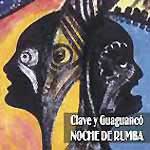Clave y Guaguancó
Noche de la Rumba
Tumi (www.tumi.music.ndirect.co.uk)
 Clave y Guaguancó has been a leading rumba exponent since the 1940s. The consummate expression of Afro-Cuban cultural style, rumba fuses the melodic sensibilities, harmonic tonalities and improvising poetics of Spanish Andalusia with the polyrhythmic three-drum ensemble, call-and-response form, and kinesthetic élan of West African music and dance. After emancipation in the 1880s, rural migrants arriving in Matanzas and Havana formed Afro-Cuban mutual aid societies whose huge, lively coro y clave vocal and percussion ensembles remade the urban musical landscape. The repertoire, idiom and communal spirit of these competitive lyric choirs gave rise to the coro de guaguancó, preceding today's smaller rumba ensemble. Guaguancó, columbia and yambú, rumba's core styles, live on in Havana and Matanzas, where spontaneous rumba gatherings are a daily occurrence. The recordings of Clave y Guaguancó, long a regular presence on Cuban radio, TV, stage and cinema, only became generally available off-island in 1994 (Songs and Dances, Xenophile).
Clave y Guaguancó has been a leading rumba exponent since the 1940s. The consummate expression of Afro-Cuban cultural style, rumba fuses the melodic sensibilities, harmonic tonalities and improvising poetics of Spanish Andalusia with the polyrhythmic three-drum ensemble, call-and-response form, and kinesthetic élan of West African music and dance. After emancipation in the 1880s, rural migrants arriving in Matanzas and Havana formed Afro-Cuban mutual aid societies whose huge, lively coro y clave vocal and percussion ensembles remade the urban musical landscape. The repertoire, idiom and communal spirit of these competitive lyric choirs gave rise to the coro de guaguancó, preceding today's smaller rumba ensemble. Guaguancó, columbia and yambú, rumba's core styles, live on in Havana and Matanzas, where spontaneous rumba gatherings are a daily occurrence. The recordings of Clave y Guaguancó, long a regular presence on Cuban radio, TV, stage and cinema, only became generally available off-island in 1994 (Songs and Dances, Xenophile).
This spirited follow-up unites the 12-person company with some notable guests, including percussion maestro José Luis Quintana "Changuito" and singer Celeste Mendoza (1935-1998; here in her last recording). Afro-Cuban poet laureate Eloy Machado "El Ambia" joins on "Suenan las claves," in dramatic recitation of his own verse, while guest guitarist Nolberto Rodríguez González gives an Andalusian texture to "Como ruge la candela," whose syncopated palmas and vocal-percussive interplay declares rumba's unwavering claim to the hybrid cultural soul of Afro-Cuban music. - Michael Stone
